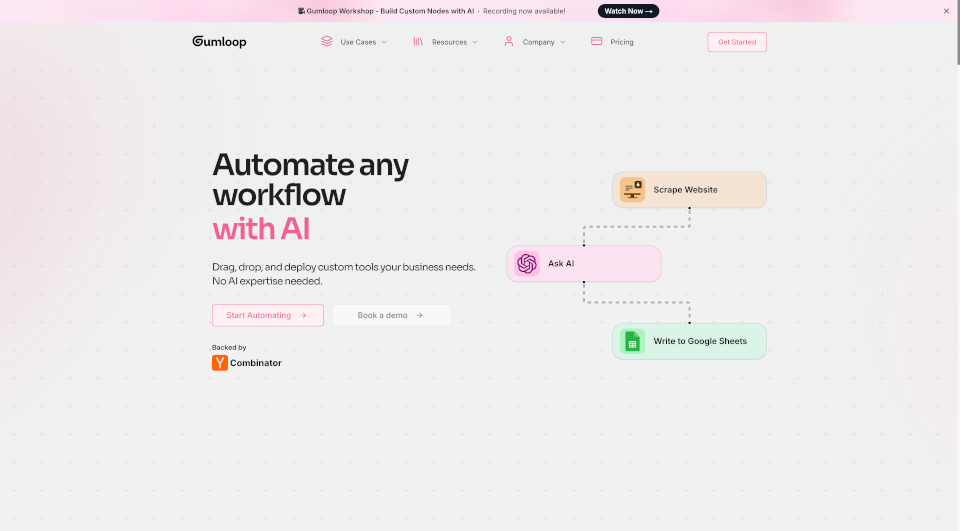What is Gumloop?
Gumloop is an innovative no-code platform designed to revolutionize the way businesses automate their workflows using AI. By allowing users to drag, drop, and deploy custom tools, Gumloop caters to users without any AI expertise, making complex automations accessible and efficient. With a diverse library of nodes, businesses can seamlessly integrate various functions like web scraping, data analysis, and more, propelling their operations into the future of automation.
What are the features of Gumloop?
One of the standout features of Gumloop is its extensive library of nodes, which enables users to build customized workflows effortlessly. This library encompasses tools for various functions, including scraping websites, using AI to process data, and writing directly to Google Sheets. Each node can be easily connected, allowing for a fluid transfer of data from one action to another, creating a cohesive automation experience.
Another significant feature is the auto-scaling compute system, which automatically adjusts resources based on demand. This ensures optimal performance, especially for businesses with fluctuating workloads. Moreover, parallelized execution allows multiple steps within a workflow to run simultaneously, drastically reducing processing time and enhancing overall efficiency.
In terms of security, Gumloop takes data protection seriously with state-of-the-art encryption for data both at rest and during transmission. The platform also adheres to SOC 2 & GDPR compliance, promising users that their data remains untouched for AI training without compromising privacy.
What are the characteristics of Gumloop?
Gumloop is characterized by its user-friendly interface that allows even individuals with no coding background to navigate the platform with ease. The platform’s drag-and-drop functionality simplifies the process of creating automations, enabling quick adaptation and implementation in business processes. Additionally, Gumloop is engineered to be secure and scalable, meeting both small business needs and the complexities of larger enterprises.
The platform supports precise user permissions through fine-grained access control, ensuring that only authorized personnel can access sensitive information or execute specific automations. This balance of accessibility and security positions Gumloop as a reliable choice for organizations across various industries.
What are the use cases of Gumloop?
Gumloop provides myriad applications suited for different business needs. Here are some scenarios where the platform shines:
-
Web Scraping: Businesses can automate the process of gathering data from various websites, collecting valuable insights for research or competitive analysis.
-
SEO Optimization: With its capabilities, Gumloop can streamline processes like keyword analysis, backlink monitoring, and content optimization, improving search engine rankings.
-
Document Processing: Automating data extraction from documents can save teams countless hours, converting text and figures into usable formats.
-
Sales and Marketing Automation: From generating leads through web scraping to writing customer data into CRMs, businesses can optimize their marketing strategies significantly.
-
Data Analysis: Users can leverage AI to analyze raw data, drawing conclusions and insights that drive better business decisions.
How to use Gumloop?
Using Gumloop is a simple process that involves three main steps:
-
Pick & Place: Begin by exploring the growing library of nodes. You can easily select the nodes relevant to your workflow and drag them into the workspace.
-
Connect the Nodes: Once your nodes are in place, link them together using the intuitive drag-and-click connections. This sets the path for data to flow seamlessly from one node to another.
-
Run Your Workflow: After setting up, test your workflow in the sandbox environment to ensure everything functions as expected. Once verified, you can deploy your automation, sharing it with your team or using it internally.
